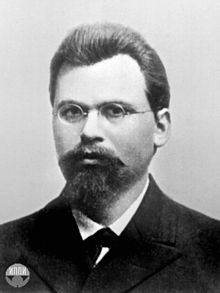Georgy Voronoi
| Georgy Voronoy | |
|---|---|
 |
|
| Born |
28 April 1868 Zhuravki, Poltava Governorate, Russian Empire |
| Died | 20 November 1908 (aged 40) Warsaw, Congress Poland |
| Citizenship | Russian Empire |
| Fields | continued fractions |
| Institutions | University of Warsaw |
| Alma mater | Saint Petersburg University |
| Doctoral advisor | Andrey Markov |
| Doctoral students |
Wacław Sierpiński Boris Delaunay |
| Known for | Voronoi diagram |
Georgy Feodosevich Voronoy (Ukrainian: Георгій Феодосійович Вороний; Russian: Гео́ргий Феодо́сьевич Вороно́й; 28 April 1868 – 20 November 1908) was a Russian and Ukrainian mathematician. Among other things, he defined the Voronoi diagram.
Voronoy was born in the village of Zhuravky, district of Pyriatin, in Poltava Governorate of the Russian Empire (now Varvynsky Raion, Chernihiv Oblast, Ukraine).
From 1889, Voronoy studied at Saint Petersburg University, where he was a student of Andrey Markov. In 1894 he defended his master's thesis On algebraic integers depending on the roots of an equation of third degree. In the same year, Voronoy became a professor at the University of Warsaw, where he worked on continued fractions. In 1897, he defended his doctoral thesis On a generalisation of a continuous fraction.
Following a severe illness, Voronoy died on November 20, 1908.
Among his students was Wacław Sierpiński (Ph.D. at Jagiellonian University in 1906). Although he was not formally the doctoral advisor of Boris Delaunay (Ph.D. at Kiev University), his influence on the latter earns him the right to be considered so.
In 2008 Ukraine released two-hryvnia coins commemorating the centenary of Voronoy's death.
...
Wikipedia
